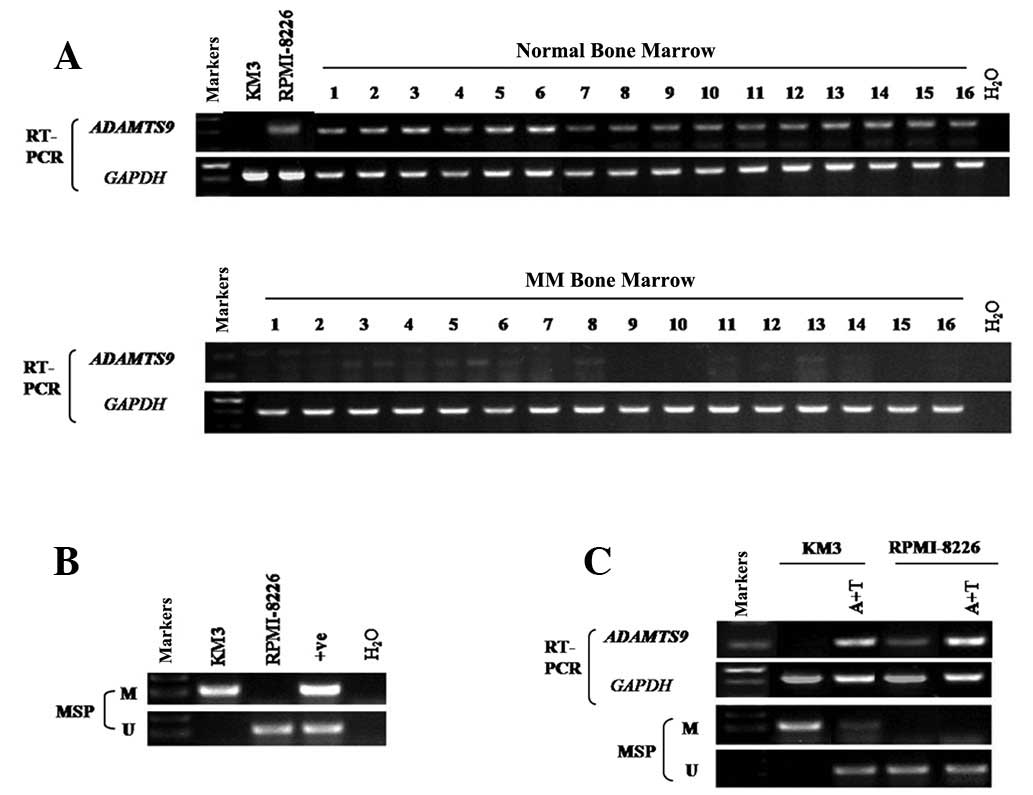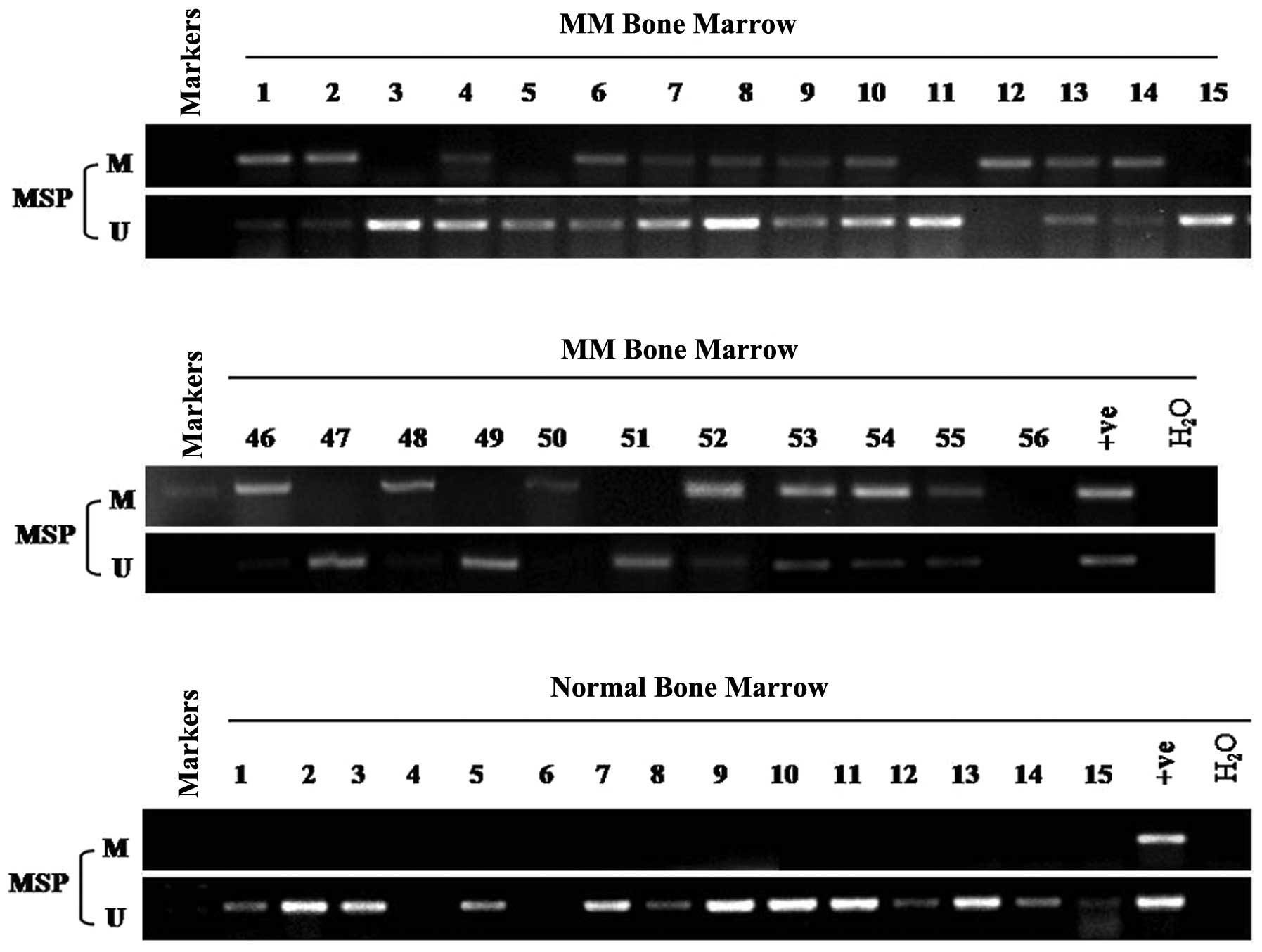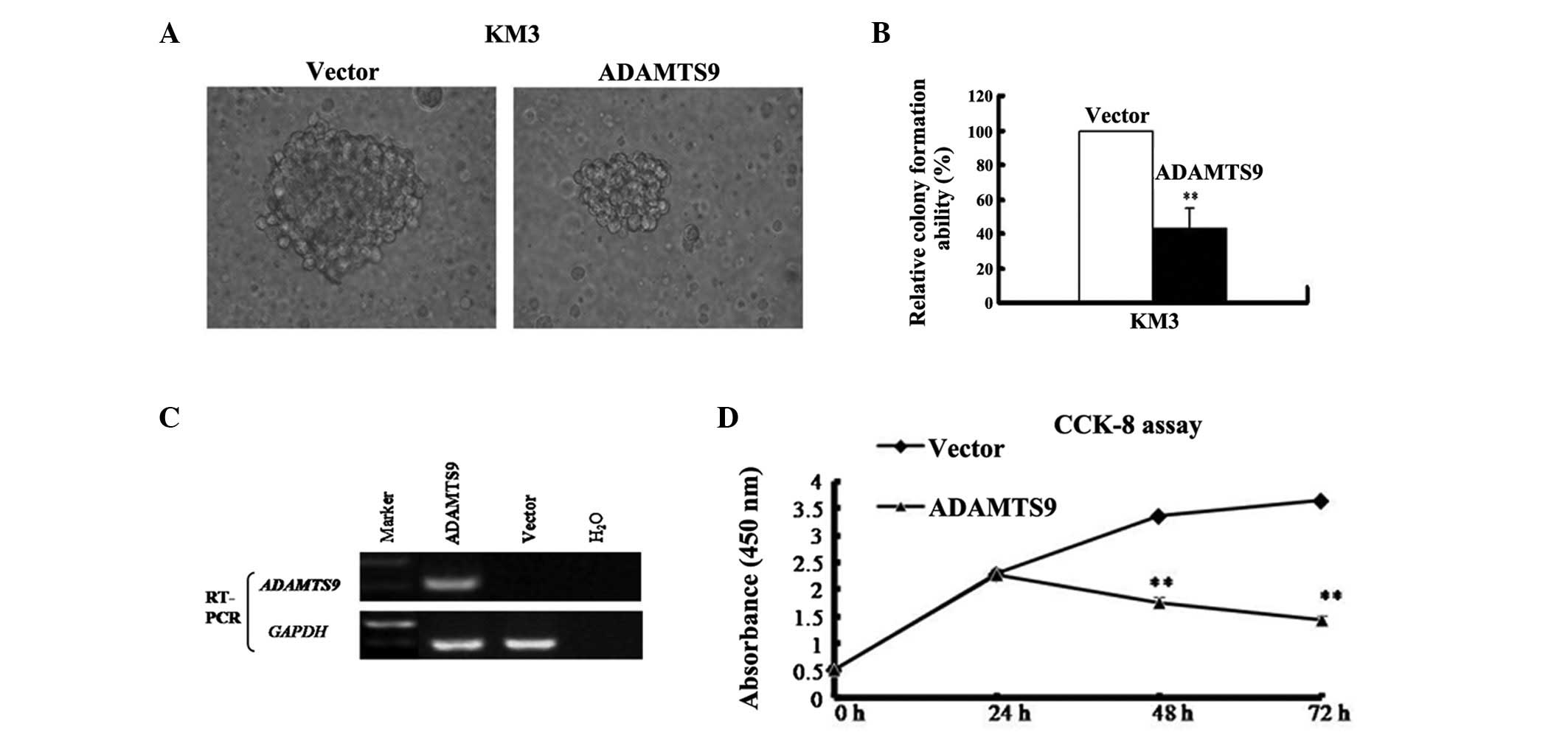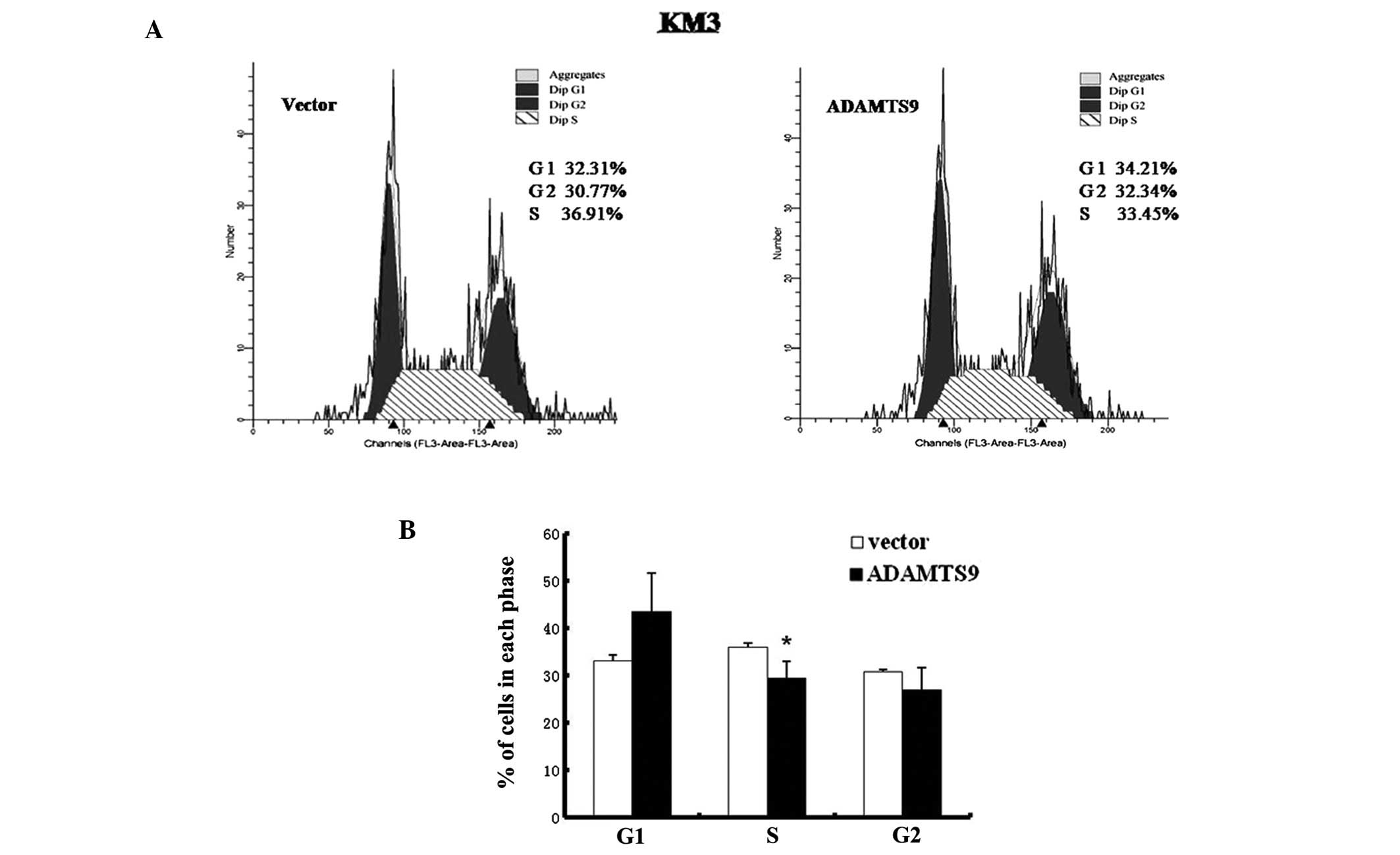Epigenetic inactivation of ADAMTS9 via promoter methylation in multiple myeloma
- Authors:
- Published online on: January 28, 2013 https://doi.org/10.3892/mmr.2013.1291
- Pages: 1055-1061
Abstract
Introduction
Multiple myeloma (MM) is a plasma cell malignancy and the second most common hematological malignancy after non-Hodgkin lymphoma (1). Despite advances in supportive and systemic therapies, MM remains an essentially incurable disease with a high rate of relapse and a rapid acquisition of drug resistance. The development of MM is a multistep process associated with an increasing frequency of genetic aberrations, including chromosomal abnormalities, as well as complex translocations, including the complete deletion of chromosome 13 or its long arm. In addition, increased density of bone marrow (BM) microvessels is associated with MM development (2–4).
However, an increasing number of studies are reporting that, in addition to genetic abnormalities, epigenetic processes play a major role in the carcinogenesis of MM (5,6). DNA methylation of cytosine bases within a CpG dinucleotide represents a major epigenetic modification that results in altered transcriptional activity in the molecular pathogenesis of various hematological malignancies (7). In MM, numerous cases of epigenetic silencing of tumor suppressor genes (TSGs), including p15, p16, DAP-kinase, CDH1, DLC1, SOCS-1 and E-Cadherin, have been reported (8–11). In addition, a member of the a disintegrin-like and metalloprotease with thrombospondin type I motifs (ADAMTS) family has been suggestedc to be involved in processes regulating epigenetic gene silencing in MM.
The ADAMTS superfamily is involved in a wide range of cellular processes, including the maturation of procollagen and the extracellular matrix proteolysis associated with morphogenesis, cancer, angiogenesis, arthritis and ovulation. Several members of the ADAMTS family (ADAMTS9, ADAMTS12, ADAMTS15 and ADAMTS18) have been reported as candidate TSGs.
ADAMTS9, which is located at 3p14.2, is the most highly conserved member of this superfamily. ADAMTS9 is involved in a number of biological processes, including melanoblast development, vascular development and the suppression of angiogenesis in the tumor context (12). The gene functions as a TSG via promoter methylation in various types of human cancer, such as esophageal, nasopharyngeal, gastric, colorectal and pancreatic (13–15).
In the present study, the expression and promoter methylation status of ADAMTS9 was analyzed in MM cell lines and patients. Promoter hypermethylation and the re-expression of ADAMTS9 were performed using demethylating drug treatment and results revealed that promoter methylation is the key mechanism of ADAMTS9 expression inactivation in MM. Ectopic ADAMTS9 expression in KM3 cells leads to the significant suppression of colony formation and cell proliferation, indicating that ADAMTS9 is a novel functional tumor suppressor gene.
Materials and methods
Cell culture and clinical samples
KM3 and RPMI-8226 cell lines were obtained from Dr Jian Hou (The Second Military Medical University, Shanghai, China) and maintained in RPMI-1640 medium supplemented with 10% fetal bovine serum (both Gibco-BRL, Carlsbad, CA, USA). A total of 32 male and 24 female patients with a median age of 64 (range, 38–78) years, recently diagnosed with MM, as well as 16 healthy adults, who served as controls, were included in the study. Patients were previously untreated. BM samples were obtained from the Hematology Laboratory of The First Affiliated Hospital of Chongqing Medical University (Chongqing, China). The diagnosis of MM was based on standard criteria (International Myeloma Working Group, 2003) and the patients were classified according to the International Staging System (ISS). The samples were confirmed to have no solid tumor infiltration. The study was conducted according to the principles of the Declaration of Helsinki and informed consent was obtained from all patients.
Methyltransferase inhibitor drug treatment
Cells were treated with 10 μM 5-aza-2′-deoxycytidine (Aza; Sigma-Aldrich, St. Louis, MO, USA) for 3 days and then with 100 ng/ml trichostatin A (TSA; Sigma-Aldrich) for an additional 24 h, as described previously (16).
Total RNA isolation and semi-quantitative reverse transcription PCR (RT-PCR)
RNA was extracted using TRIzol reagent (Invitrogen Life Technologies, Carlsbad, CA, USA) and reverse-transcribed using an RT reagent kit (Takara Bio, Inc., Shiga, Japan) and random hexamer primers. PCR analysis using Go-Tag (Promega Corporation, Madison, WI, USA) was perfomed using GAPDH as a control. ADAMTS9 expression was analyzed by PCR using the following primers: ADAMTS9, F: 5′-CAT GCA GTT TGT ATC CTG-3′ and R: 5′-GCG TTC TTT TGA AGT GGA CG -3′; GAPDH, F: 5′-ATC TCT GCC CCC TCT GCT GA-3′ and R: 5′-GAT GAC CTT GCC CAC AGC CT-3′. RT-PCR was performed with 32 cycles for ADAMTS9 and 23 cycles for GAPDH.
DNA bisulfite treatment and methylation-specific polymerase chain reaction (MSP)
Genomic DNA was extracted using the QIAmp DNA blood Mini kit (Qiagen, Hilden, Germany) according to the manufacturer's instructions. Bisulfite modification of DNA and methylation of the CpG islands of the ADAMTS9 promoter were performed as described previously (13). The primers detecting the methylated or unmethylated alleles of the ADAMTS9 promoter were as follows: ADAMTS9-m1: 5′-TTT TTC GTT TTT TTT TGT TCG TTC-3′ and -m2: 5′-AAA CTA AAC CGC TCG AAC CG-3′ for the methylated alleles and ADAMTS9-u1: 5′-GTT TTT TGT TTT TTT TTG TTT GTT T-3′ and -u2: 5′-AAA AAC TAA ACC ACT CAA ACC A-3′ for the unmethylated alleles. MSP was performed for 40 cycles using Ampli Taq-Gold under methylation- and unmethylation-specific primer conditions: annealing temperature 60 and 58°C, respectively. The MSP primers were tested previously to ensure that DNA that was not modified by bisulfite was not amplified.
Cell transfection
Transfection plasmids were purified using the TIANprep Mini Plasmid kit [Tiangen Biotech (Beijing) Co., Ltd., Beijing, China]. KM3 cells (2×105 cells/well) were plated in 6-well plates and transfected with the expression plasmid (2 μg), pCEP4-ADAMTS9 or the empty vector (2 μg), pCEP4, using Lipofectamine 2000 (Invitrogen Life Technologies) according to the manufacturer's instructions. Cells were collected and plated in a 5-cm dish 48 h post-transfection and selected for 21 days with G418 (0.4 mg/ml).
Colony formation assay
Colony formation assay was performed using semi-solid medium. Cells were suspended in RPMI-1640 medium containing 1% methylcellulose, 35% fetal bovine serum and 0.8 mg/ml G418 in a 5-cm dish 48 h post-transfection. The dish was placed in a sealed chamber and incubated at 37°C in a 5% CO2 incubator for 21 days. The number of surviving colonies (≥50 cells/colony)/cm3 was quantified using an inverted microscope. Total RNA from the transfected cells was extracted and analyzed via RT-PCR to confirm the ectopic expression of ADAMTS9. The experiments were performed in triplicate wells 3 times.
Flow cytometric analysis of the cell cycle
KM3 cells were plated in 6-well plates and transfected with 4 μg pCEP4-ADAMTS9 or the empty vector, pCEP4, using Lipofectamine 2000 according to the manufacturer's instructions. Stable ADAMTS9 expression and vector-KM3 cells were harvested and fixed in ice-cold 70% ethanol for 1 h. Cell cycle profiles were assayed using an Elite ESP flow cytometer and the data were analyzed using CellQuest software (BD Biosciences, Franklin Lakes, NJ, USA).
Measurement of cell proliferation
The impact of the ectopic expression of ADAMTS9 on KM3 cell proliferation was assessed using the Cell Counting kit-8 (CCK-8) (Beyotime Institute of Biotechnology, Jiangsu, China) according to the manufacturer's instructions. Briefly, KM3 cells were transfected as described above and cultured at a density of 3×103 cells/well in 96-well plates. Cell proliferation was monitored at 24, 48 and 72 h, 20 μl CCK-8 solution was added to each well following 1 h incubation in a 5% CO2 humidified incubator at 37°C and the optical density was measured at 450 nm using a microplate reader (Molecular Devices LLC, Sunnyvale, CA, USA). Experiments were performed in 5 wells/experiment and repeated 3 times.
Statistical analysis
Statistical analyses were performed using SAS version 9.1 for windows (SAS Institute Inc., Cary, NC, USA). Data were presented as the mean ± SD. Associations between the ADAMTS9 methylation status of the tumor and non-tumor samples and the clinical characteristics were assessed using Chi-square, Fisher's exact and Student's t-tests. Differences between the subgroups (colony formation assay, cell cycle analysis and proliferation measurement) were assessed using the Student's test. P<0.05 was considered to indicate a statistically significant difference.
Results
ADAMTS9 was expressed in healthy normal adult tissues and frequently silenced in MM cell lines and patient samples
Expression levels of ADAMTS9 were analyzed in KM3 and RPMI-8226 cells, 16 MM BM samples and 16 normal adult BM samples with semi-quantitative RT-PCR. The results revealed that ADAMTS9 was silenced in 100% (16/16) of the MM samples (Fig. 1A), while its expression was readily detected in the normal adult BM samples (0/16) (Fig. 1A). In addition, among the two MM cell lines tested, KM3 revealed no ADAMTS9 expression (Fig. 1A). By contrast, ADAMTS9 expression was detected in RPMI-8226 cells (Fig. 1A).
Frequent silencing of ADAMTS9 in MM cell lines due to promoter methylation
As aberrant promoter CpG methylation is associated with gene silencing, the methylation status of the MM cell lines was determined using MSP. ADAMTS9 was methylated in KM3 (Fig. 1B), while methylation was not observed in RPMI-8226 cells and normal adult BM (Figs. 1B and 2), consistent with the hypothesis that ADAMTS9 methylation is negatively correlated with ADAMTS9 expression levels.
Activation of ADAMTS9 expression via pharmacological demethylation
To examine whether promoter methylation of ADAMTS9 directly mediates expression silencing, cells were treated with the DNA methyltransferase inhibitor, Aza, combined with the histone deacetylase inhibitor, TSA. ADAMTS9 expression was markedly induced following drug treatment in KM3 cells (Fig. 1C), accompanied with a decrease in methylated alleles and an increase in unmethylated alleles of the ADAMTS9 promoter in KM3 cells (Fig. 1C). However, no difference was observed in RPMI-8226 cells (Fig. 1C). The results indicate that DNA methylation of the ADAMTS9 promoter is directly involved in transcriptional silencing in MM cells.
Frequent ADAMTS9 methylation and clinicopathological correlations in MM
MSP was used to analyze the methylation status of ADAMTS9 in 56 MM and 15 normal adult BM samples. Aberrant promoter methylation was detected in 66% (37/56) of the MM BM samples (Table I, Fig. 2), while no methylation was detected in any of the 15 normal adult samples (Fig. 2). Potential correlations between the ADAMTS9 methylation status and clinical parameters were determined, including gender, age, MM subtype, ISS staging system (Table II). However, no significant correlations were observed between the patients with methylated ADAMTS9 and these clinicopathological characteristics.
Table IICorrelations between ADAMTS9 promoter methylation and clinicopathological indices of MM patients (n=56). |
Ectopic expression of ADAMTS9 suppresses tumor cell clonogenicity
The frequent silencing of ADAMTS9 in MM cell lines compared with its broad expression in normal tissues indicates that ADAMTS9 may exert tumor suppressor functions in this tumor type. To verify this hypothesis, a colony formation assay was performed to test for the growth-inhibitory effect of ADAMTS9 in KM3 cells with complete methylation and silencing of ADAMTS9 (Fig. 3A). The ADAMTS9-expressing and empty vector (control) were transfected into KM3 cells. The cells were then selected with 400 μg/ml G418 (Merck, Darmstadt, Germany) to obtain stably transfected cells. Following G418 selection for 2 weeks, ADAMTS9 was stably overexpressed as revealed by RT-PCR (Fig. 3C). A sharp reduction in colonies (40–60% of the control vector; P<0.01) was observed in the KM3-ADAMTS9 cells compared with the empty vector control (Fig. 3B). These results indicate that ADAMTS9 suppresses colony formation and may act as a tumor suppressor in MM cells.
Ectopic expression of ADAMTS9 inhibits tumor cell proliferation and induces S-phase cell cycle arrest
The CCK-8 assay was employed to examine the effect of ADAMTS9 on MM cell proliferation in vitro. The growth of ADAMTS9- and vector-expressing KM3 cells was observed at 0, 24, 48 and 72 h. The proliferation trend was identified to be significantly decreased in ADAMTS9-expressing KM3 cells at 48 and 72 h (P<0.01) but increased in the vector-expressing KM3 cells in a time-dependent manner (Fig. 3D). To examine the mechanism by which ADAMTS9 inhibits the proliferation of KM3 cells in vitro, the effect of ADAMTS9 expression on cell cycle distribution was investigated using flow cytometry (Fig. 4A). As demonstrated in Fig. 4B, the proportion of cells in the S phase decreased significantly in ADAMTS9-transfected KM3 cells, which was accompanied by an increase in cells in the G1 phase compared with the empty vector-transfected KM3 cells (P<0.05). These observations are consistent with the hypothesis that the inhibitory effect of cell proliferation induced by ADAMTS9 expression is mediated by cell cycle arrest in the S phase.
Discussion
Aberrant promoter methylation may be important in the carcinogenic process (17). Previously, a number of genes, including PTGS2, SFN, CDKN2B, CDH1, ESR1, HIC1, CCND2 and TGFβR2, were found to be silenced in association with aberrant methylation in MM (18). Analysis of esophageal and nasopharyngeal cancer demonstrated that the aberrant methylation of ADAMTS9 is important for malignancy (13). However, ADAMTS9 methylation has not been detected in MM.
The present study confirms that ADAMTS9 is abundantly expressed in normal adult BM samples and RPMI-8226 cells but silenced in KM3 cells and MM BM samples, thereby indicating that ADAMTS9 plays a vital role in the pathogenesis of MM. This study revealed that promoter methylation of ADAMTS9 occurs in KM3 cells and in 66% of MM samples. These observations indicate that the disruption of ADAMTS9 in MM is markedly associated with aberrant promoter methylation. However, methylation was not detected in RPMI-8226 cells. This demonstrates that methylation of ADAMTS9 is not the only cause of MM and the involvement of additional mechanisms cannot be excluded. Therefore, further studies are required to understand the mechanism of MM development.
Previously, ADAMTS9 expression was found to significantly correlate with lymph node metastases in nasopharyngeal carcinoma (14). However, a significant association was not observed between the methylation status of ADAMTS9 and the clinicopathological indices of our 56 MM patients, indicating that ADAMTS9 methylation may be an early event in MM tumorigenesis. However, the clinical impact of ADAMTS9 inactivation via promoter methylation in MM remains unknown. To assess the correlation between methylation levels of ADAMTS9 with the clinical parameters, studies with larger cohorts, as well as more potential diagnostic and prognostic clinical features are required. ADAMTS9 promoter methylation was detected at a high frequency in MM tissues but not in normal tissues, thereby demonstrating that ADAMTS9 may be a potential cancer-specific biomarker for MM diagnosis. To the best of our knowledge, this is the first study to identify that ADAMTS9 is epigenetically silenced in human MM.
Silencing of ADAMTS9 may be activated by pharmacological demethylation, suggesting that aberrant promoter methylation is a mechanism for ADAMTS9 silencing in MM cells. In the current study, colony-formation, flow cytometry and CCK-8 assay results revealed that as a tumor suppressor, ADAMTS9 suppresses tumor cell clonogenicity and cell proliferation, which may be mediated by cell cycle arrest at the S phase following ADAMTS9 re-expression. Lung et al(14) demonstrated that a marked reduction in the colony-forming ability was observed following transfection of ADAMTS9 into NPC cell lines, which is consistent with our study.
ADAMTS9, together with other members of the ADAMTS family, is involved in tumorigenesis (19–23), which may be associated with anti-angiogenic activity (13, 24–26). Previously, ADAMTS9 was revealed to be a cell-autonomous angiogenesis inhibitor (27). In addition, ADAMTS9 has been identified to function in angiogenesis, however, its role in MM tunorigenesis remains unclear. Further analyses must be conducted to improve understanding of the underlying mechanism.
In conclusion, ADAMTS9 was identified to be frequently silenced by promoter methylation in MM in a cancer-specific manner, which may be reversed by treatment with a demethylation reagent. The transfection of ADAMTS9 into MM cells lacking ADAMTS9 expression led to a reduction in cell colony forming ability and cell proliferation mediated by cell cycle arrest in the S phase, indicating that epigenetic inactivation of ADAMTS9 is an important factor in MM carcinogenesis. ADAMTS9 may be a candidate tumor suppressor in MM. Further studies are underway to evaluate the possible application of ADAMTS9 as a biomarker for the diagnosis and treatment of MM and to explore its possible impact on the pathways involved in MM development.
Acknowledgements
The authors thank Dr Jian Hou (The Second Military Medical University, Shanghai, China) for providing the MM cells and the Laboratory of Hematology (the First Affiliated Hospital of Chongqing Medical University) for providing BM samples. The present study was supported by grants from the National Natural Science Foundation of China (nos. 31171243 and 81072148).
References
|
Hatzimichael E, Dasoula A, Benetatos L, et al: Study of specific genetic and epigenetic variables in multiple myeloma. Leuk Lymphoma. 51:2270–2274. 2010. View Article : Google Scholar : PubMed/NCBI | |
|
Rajumar SV and Greipp PR: Prognostic factors in multiple myeloma. Hematol Oncol Clin North Am. 13:1295–1314. 1999. View Article : Google Scholar | |
|
Kyle RA and Rajkumar SV: Multiple myeloma. N Engl J Med. 351:1860–1873. 2004. View Article : Google Scholar | |
|
Klein U, Jauch A, Hielscher T, et al: Chromosomal aberrations +1q21 and del(17p13) predict survival in patients with recurrent multiple myeloma treated with lenalidomide and dexamethasone. Cancer. 117:2136–2144. 2011. | |
|
Esteller M: Epigenetics in cancer. N Engl J Med. 358:1148–1159. 2008. View Article : Google Scholar | |
|
Jost E, Gezer D, Wilop S, et al: Epigenetic dysregulation of secreted Frizzled-related proteins in multiple myeloma. Cancer Lett. 281:24–31. 2009. View Article : Google Scholar : PubMed/NCBI | |
|
Boultwood J and Wainscoat JS: Gene silencing by DNA methylation in haematological malignancies. Br J Haematol. 138:3–11. 2007. View Article : Google Scholar : PubMed/NCBI | |
|
Yuregir OO, Yurtcu E, Kizilkilic E, Kocer NE, Ozdogu H and Sahin FI: Detecting methylation patterns of p16, MGMT, DAPK and E-cadherin genes in multiple myeloma patients. Int J Lab Hematol. 32:142–149. 2010. View Article : Google Scholar : PubMed/NCBI | |
|
Braggio E, Maiolino A, Gouveia ME, et al: Methylation status of nine tumor suppressor genes in multiple myeloma. Int J Hematol. 91:87–96. 2010. View Article : Google Scholar : PubMed/NCBI | |
|
Ullmannova-Benson V, Guan M, Zhou X, et al: DLC1 tumor suppressor gene inhibits migration and invasion of multiple myeloma cells through RhoA GTPase pathway. Leukemia. 23:383–390. 2009. View Article : Google Scholar : PubMed/NCBI | |
|
Galm O, Yoshikawa H, Esteller M, Osieka R and Herman JG: SOCS-1, a negative regulator of cytokine signaling, is frequently silenced by methylation in multiple myeloma. Blood. 101:2784–2788. 2003. View Article : Google Scholar : PubMed/NCBI | |
|
Levy GG, Nichols WC, Lian EC, et al: Mutations in a member of the ADAMTS gene family cause thrombotic thrombocytopenic purpura. Nature. 413:488–494. 2001. View Article : Google Scholar : PubMed/NCBI | |
|
Lo PH, Lung H, Cheung AK, et al: Extracellular protease ADAMTS9 suppresses esophageal and nasopharyngeal carcinoma tumor formation by inhibiting angiogenesis. Cancer Res. 70:5567–5576. 2010. View Article : Google Scholar : PubMed/NCBI | |
|
Lung HL, Lo PH, Xie D, et al: Characterization of a novel epigenetically-silenced, growth-suppressive gene, ADAMTS9 and its association with lymph node metastases in nasopharyngeal carcinoma. Int J Cancer. 123:401–408. 2008. View Article : Google Scholar : PubMed/NCBI | |
|
Zhang C, Shao Y, Zhang W, et al: High-resolution melting analysis of ADAMTS9 methylation levels in gastric, colorectal and pancreatic cancers. Cancer Gene Cytogenet. 196:38–44. 2010. View Article : Google Scholar : PubMed/NCBI | |
|
Kuo HK, Griffith JD and Kreuzer KN: 5-Azacytidine induced methyltransferase-DNA adducts block DNA replication in vivo. Cancer Res. 17:8248–8254. 2007. View Article : Google Scholar : PubMed/NCBI | |
|
Sidransky D: Emerging molecular markers of cancer. Nat Rev Cancer. 2:210–219. 2002. View Article : Google Scholar | |
|
de Carvalho F, Colleoni GW, Almeida MS, Carvalho AL and Vettore AL: TGFβR2 aberrant methylation is a potential prognostic marker and therapeutic target in multiple myeloma. Int J Cancer. 125:1985–1991. 2009. | |
|
Lo PH, Leung AC, Kwok CY, et al: Identification of a tumor suppressive critical region mapping to 3p14.2 in esophageal squamous cell carcinoma and studies of a candidate tumor suppressor gene, ADAMTS9. Oncogene. 26:148–157. 2007. View Article : Google Scholar : PubMed/NCBI | |
|
Li Z, Zhang W, Shao Y, et al: High-resolution melting analysis of ADAMTS18 methylation levels in gastric, colorectal and pancreatic cancers. Med Oncol. 27:998–1004. 2010. View Article : Google Scholar : PubMed/NCBI | |
|
Moncada-Pazos A, Obaya AJ, Fraga MF, et al: The ADAMTS12 metalloprotease gene is epigenetically silenced in tumor cells and transcriptionally activated in the stroma during progression of colon cancer. J Cell Sci. 122:2906–2913. 2009. View Article : Google Scholar | |
|
Viloria CG, Obaya AJ, Moncada-Pazos A, et al: Genetic inactivation of ADAMTS15 metalloprotease in human colorectal cancer. Cancer Res. 69:4926–4934. 2009. View Article : Google Scholar : PubMed/NCBI | |
|
Dunn JR, Panutsopulo D, Shaw MW, et al: METH-2 silencing and promoter hypermethylation in NSCLC. Br J Cancer. 91:1149–1154. 2004.PubMed/NCBI | |
|
Dubail J, Kesteloot F, Deroanne C, et al: ADAMTS-2 functions as anti-angiogenic and anti-tumoral molecule independently of its catalytic activity. Cell Mol Life Sci. 67:4213–4232. 2010. View Article : Google Scholar : PubMed/NCBI | |
|
EI Hour M, Moncada-Pazos A, Blacher S, et al: Higher sensitivity of Adamts12-deficient mice to tumor growth and angiogenesis. Oncogene. 29:3025–3032. 2010.PubMed/NCBI | |
|
Dunn JR, Reed JE, du Plessis DG, et al: Expression of ADAMTS-8, a secreted protease with antiangiogenic properties, is downregulated in brain tumours. Br J Cancer. 94:1186–1193. 2006. View Article : Google Scholar : PubMed/NCBI | |
|
Koo BH, Coe DM, Dixon LJ, et al: ADAMTS9 is a cell-autonomously acting, anti-angiogenic metalloprotease expressed by microvascular endothelial cells. Am J Pathol. 176:1494–1504. 2010. View Article : Google Scholar : PubMed/NCBI |













